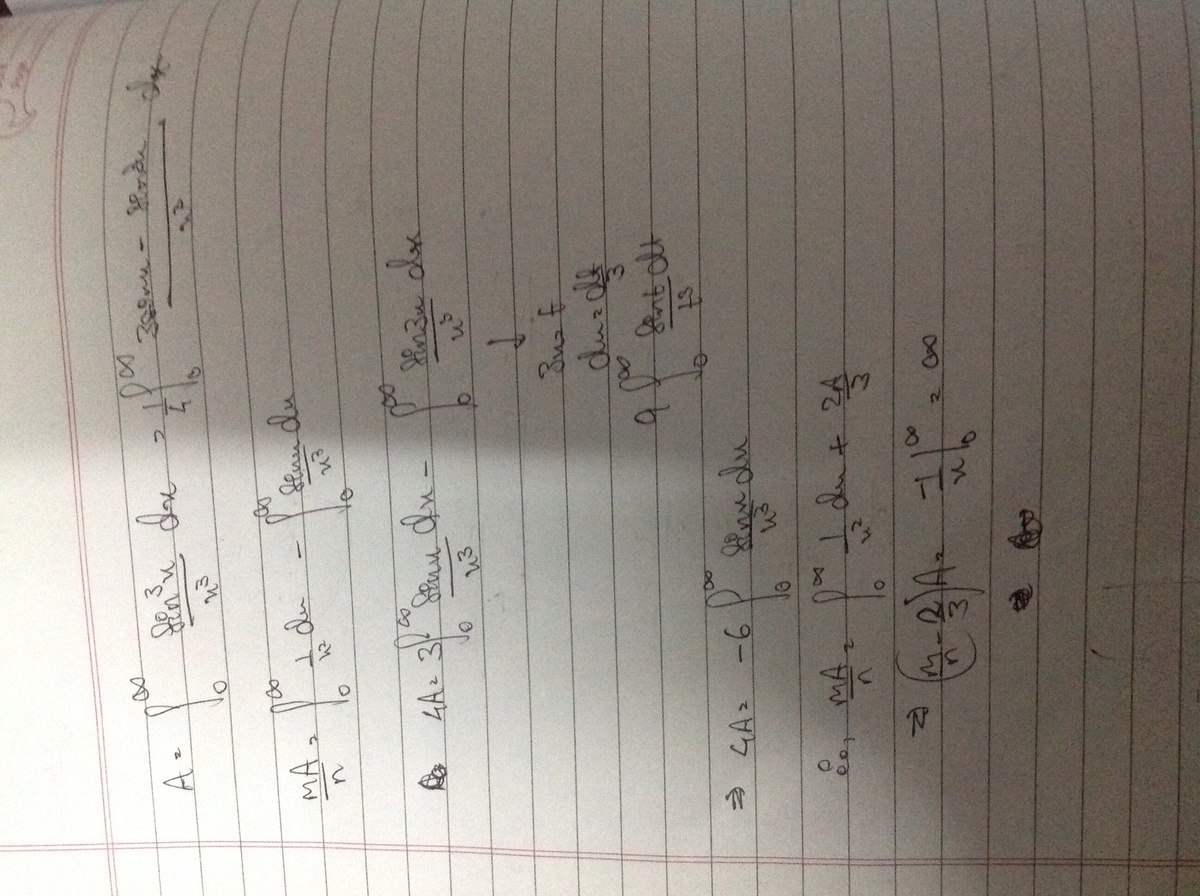No problem, Double Integral!
If ∫ 0 ∞ x 3 sin 3 x d x = A and ∫ 0 ∞ ( x 3 x − sin x ) d x = n m A where m and n are positive relative coprimes, then what is m + n ?.
The answer is 5.
This section requires Javascript.
You are seeing this because something didn't load right. We suggest you, (a) try
refreshing the page, (b) enabling javascript if it is disabled on your browser and,
finally, (c)
loading the
non-javascript version of this page
. We're sorry about the hassle.
3 solutions
This should be tidied up a little, since the individual integrals such as ∫ 0 ∞ x 3 sin x d x do not exist, and cannot be evaluated separately. What makes this problem work is the fact that the differences between various pairs of integrals do behave, so that, for example 3 sin x − sin 3 x = O ( x 3 ) x → 0 , which means that what you have written as a separate pair of terms − 8 3 [ x 2 sin x ] 0 ∞ + 8 1 [ x 2 sin 3 x ] 0 ∞ (neither of which exist) cancel out when considered as a single expression [ 8 1 x 2 sin 3 x − 3 sin x ] 0 ∞
If you wrote everything out as an integral from a to X , then let a → 0 and X → ∞ , then you would be OK. Otherwise you need to integrate (for example) x 3 3 sin x − sin 3 x by parts as a single integral, in which case all is well.
Log in to reply
does the limit x → 0 exist for x cos x
Log in to reply
No. It behaves like 1 / x near 0 . The limit of ( 1 − cos x ) / x exists and equals 0 , though.
I was taking:
[ x 2 sin x ] 0 ∞ = x → ∞ lim x 2 sin x − x → 0 lim x 2 sin x By l’H o ˆ pital’s rule = 0 + 0
Log in to reply
The limit of sin x / x 2 does not exist as x tends to 0 . It behaves like 1 / x near 0 .
Log in to reply
@Mark Hennings – Thanks, I got it. lim x → 0 x ⋅ x sin x = x 1 .
Log in to reply
@Chew-Seong Cheong – Almost. The limit is not 1 / x ; the function behaves like 1 / x (think what dividing the Maclaurin series for sin x by x 2 will look like), so there is no limit.
In the 11th step where did the the cosx/x go. Its evaluates to be infinity at x= 0
The first integral is now fine. You need to do the same sort of thing with the second one as well, integrating x 3 x − sin x by parts...
First, let's consider
sin x = 3 sin 3 x − 4 sin 3 x 3
Let u = x / 3 hence,
∫ 0 ∞ x 3 x − sin x d x = ∫ 0 ∞ u 3 × 2 7 3 u − 3 sin u + 4 sin u 3 × 3 d u
∫ 0 ∞ u 3 × 2 7 3 u − 3 sin u + 4 sin u 3 × 3 d u = ∫ 0 ∞ 3 u 3 u − sin u d u + 9 4 ∫ 0 ∞ u 3 sin u 3 d u
∫ 0 ∞ x 3 x − sin x d x = I = 3 I + 9 4 A
3 2 I = 9 4 A
I = 3 2 A = n m A
m + n = 5

Can anyone tell whats wrong in this.
A = ∫ 0 ∞ x 3 sin 3 x d x As sin 3 x = 3 sin x − 4 sin 3 x = 4 1 ∫ 0 ∞ x 3 3 sin x − sin 3 x d x = − 8 1 [ x 2 3 sin x − sin 3 x ] 0 ∞ + 8 3 ∫ 0 ∞ x 2 cos x − cos 3 x d x = − 8 3 [ x cos x − cos 3 x ] 0 ∞ − 8 3 ∫ 0 ∞ x sin x − 3 sin 3 x d x = − 8 3 ∫ 0 ∞ x sin x d x + 8 9 ∫ 0 ∞ 3 x sin 3 x d ( 3 x ) = 4 3 ∫ 0 ∞ x sin x d x Dirichlet integral = 4 3 ⋅ 2 π = 8 3 π
n m A = ∫ 0 ∞ x 3 x − sin x d x Integration by parts = [ − x 2 + 2 x 2 sin x + 2 x cos x ] 0 ∞ + 2 1 ∫ 0 ∞ x sin x d x Dirichlet integral = 2 1 ⋅ 2 π = 4 π
n m A ⟹ 8 n 3 m π ⟹ n m ⟹ m + n = 4 π = 4 π = 3 2 = 5